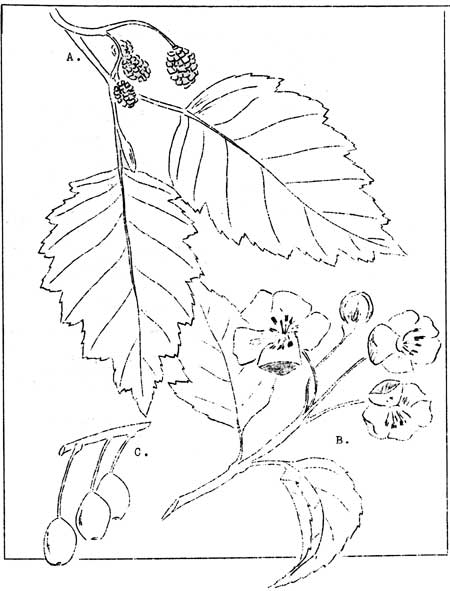RED or OREGON ALDER.
(Alnus oregona)
This is the most common deciduous tree in Mount Rainier National
Park, and occurs up to 3500 feet in elevation, generally in moist
situations, such as along stream courses and in moist, swampy soils. It
often forms groves of considerable size in such locations.
It may be easily recognized by its tall, slender trunk and
thin, light colored ash-grey bark. Under favorable conditions this
species is usually from 50-75 feet tall and 12-24 inches in
diameter when mature. The young twigs are reddish and the
buds are stalked, gummy, and reddish brown. The leaves
have coarsely toothed margins, are 3-5 inches long, and are ovate in
outline. Upon the upper sides the leaves are a dull, deep green while
the underside is covered with numerous rusty brown hairs. Both staminate
and pistillate flowers are borne on the same tree, the staminate
being particularly conspicuous in the spring when they hang from the
twigs in long tassel-like clusters, 5-6 inches long and about 1/4 inch
in diameter. The pistillate flowers are green and cone-like in form,
1/2-3/4 of an inch long and about 1/2 inch in diameter. After ripening
and shedding the seeds these "cones" are a dark brown to black in color.
It is at this time that their cone-like character is most
pronounced.
The red alder is not a long lived tree as specimens 10-20 inches in
diameter are generally from 20 to 50 years old. As it grows in moist
situations, often about swamps, it is extensively used by beaver, the
branches and smaller trunks serving as material in the construction of
dams and the bark as food for this interesting animal.
The red alder will be found from Sitka, Alaska, south along the
Pacific Coast through western British Columbia, Washington, Oregon, and
California.
-oOo-

RED or OREGON ALDER (Alnus oregona). A-Twig (x1),
illustrating the character of the foliage, pistillate cone-like
strobiles, and stalked bud.
WILD CRABAPPLE (Pyrus
diversifolia) (x1). B-Twig with foliage and flowers; C-Fruit.
(x1).
-oOo-
Descriptions continued...

